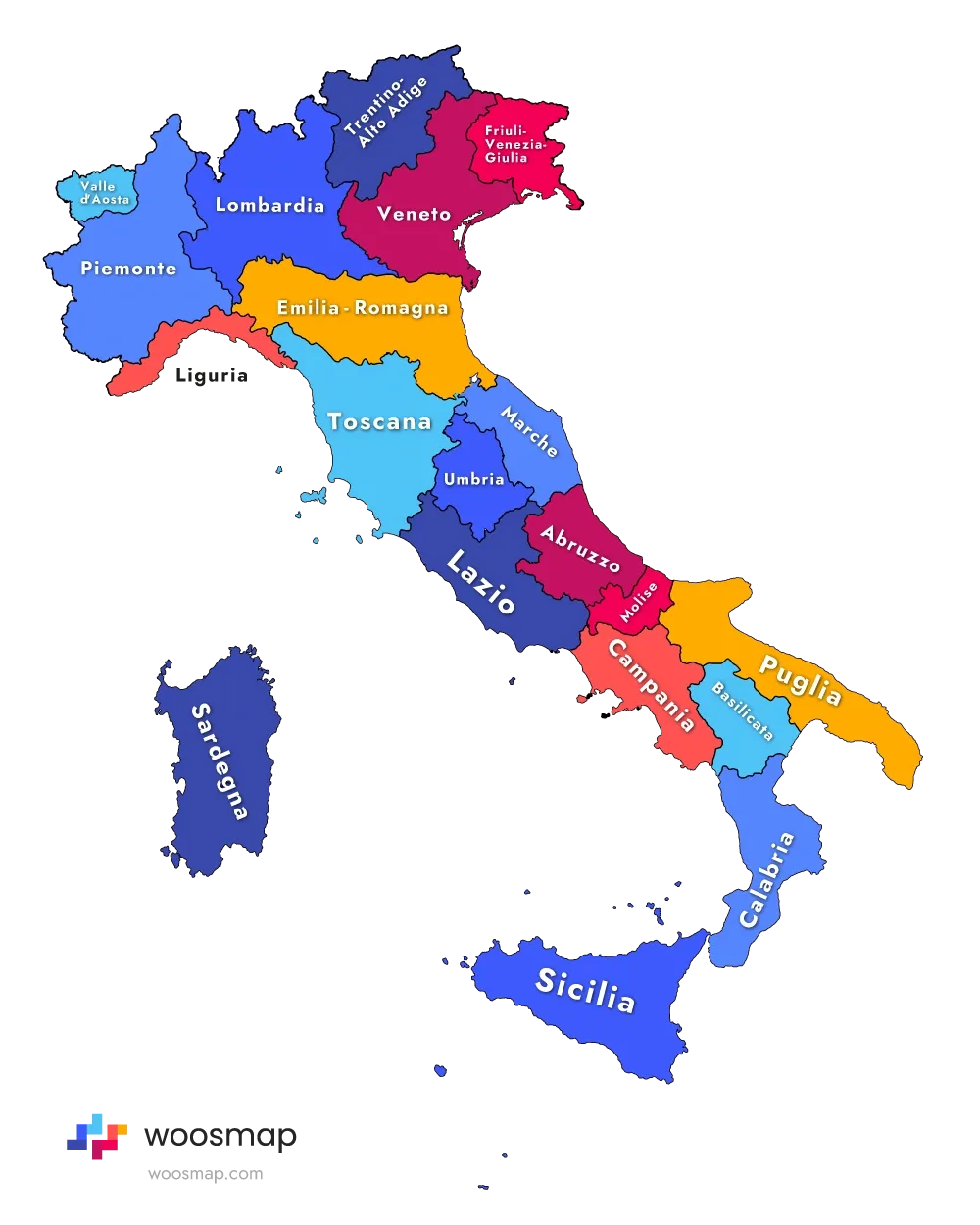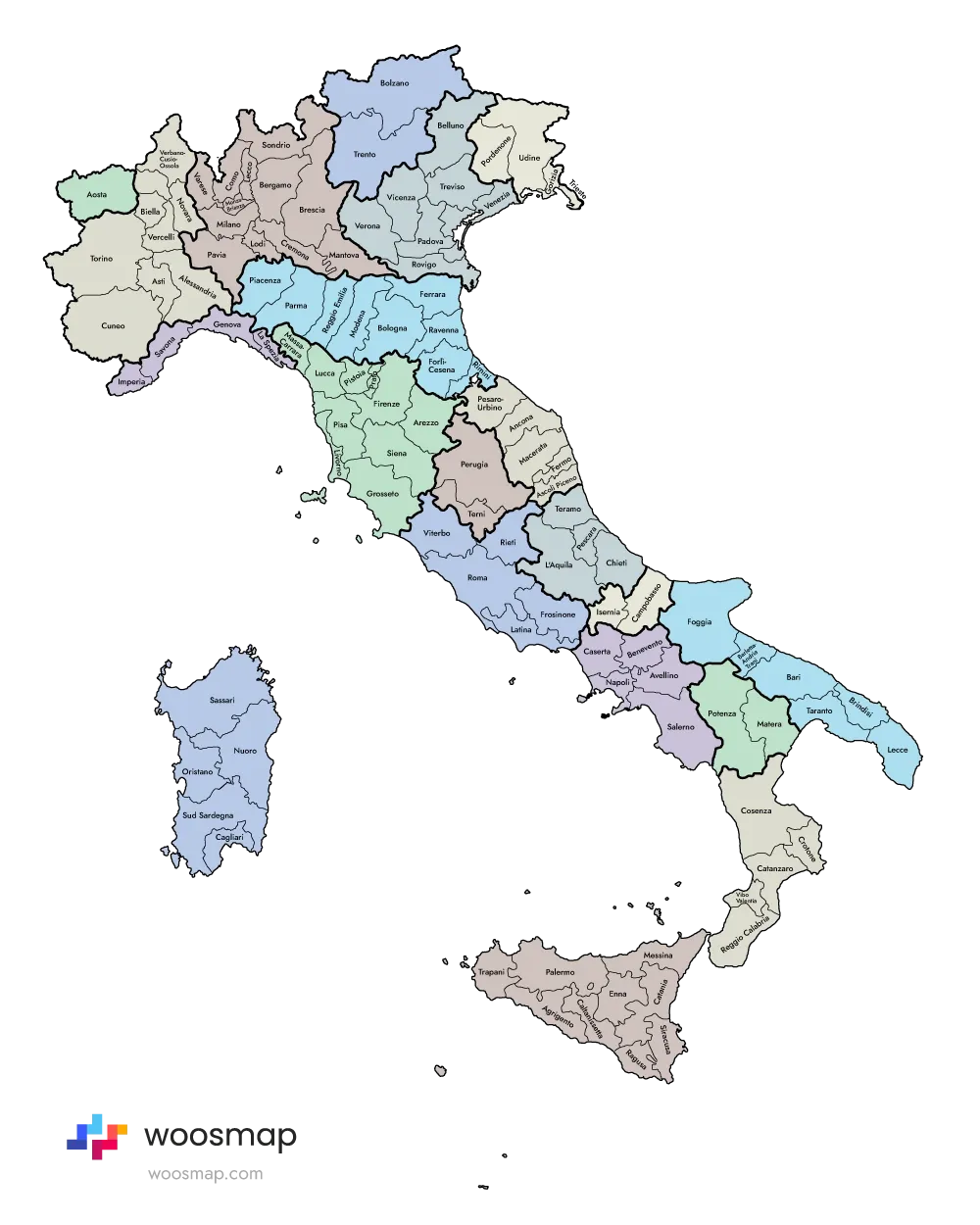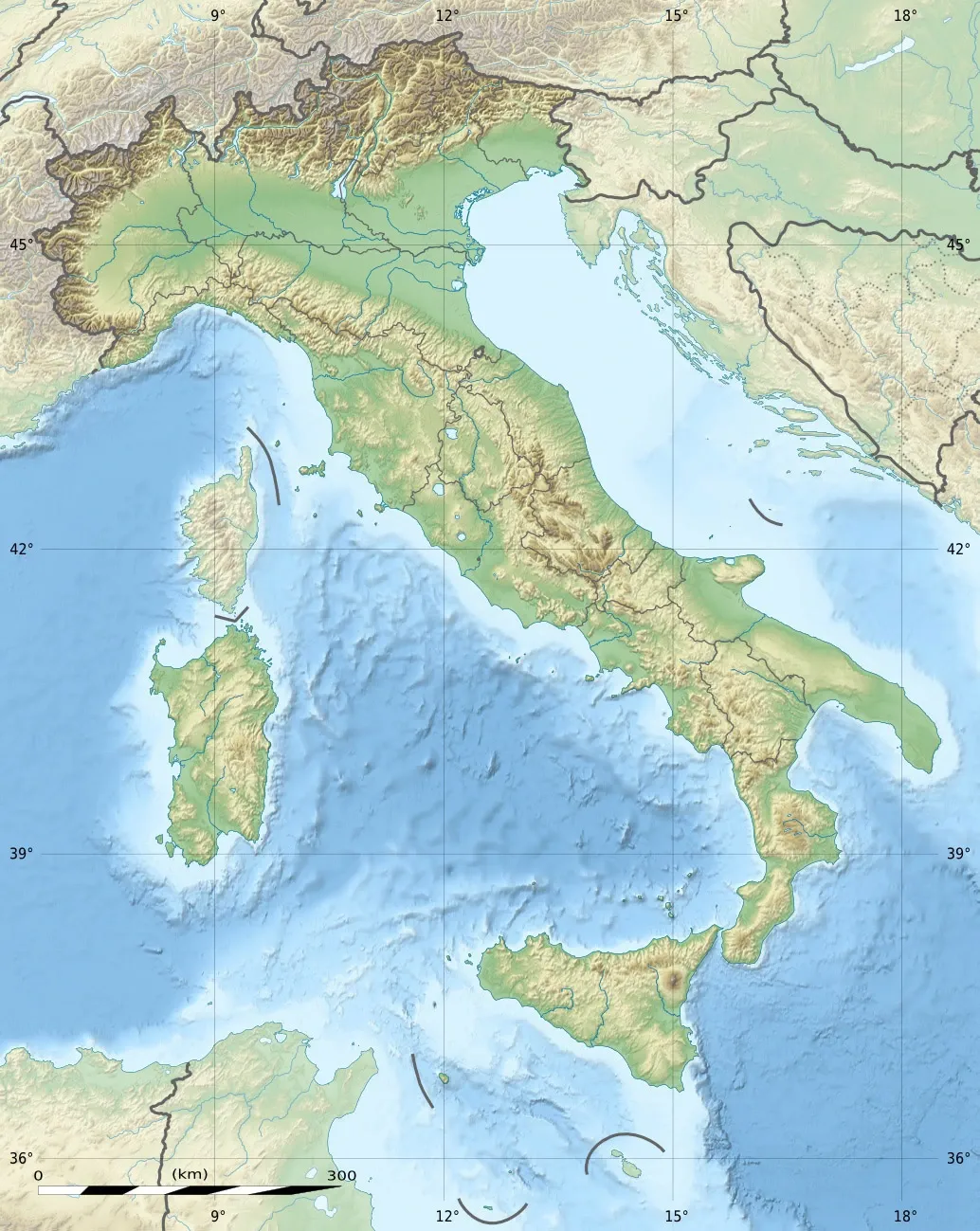Map of Italy
Embarking on a journey to Italy or just keen on its geography? A map of Italy is indispensable. Nestled in Southern Europe, Italy is embraced by the Mediterranean, Adriatic, Tyrrhenian, and Ionian Seas, presenting a scenic coastline that captivates many.
It borders France, Switzerland, Austria, Slovenia, and the tiny state of Monaco to the north. A deep dive into Italy's map unveils 20 distinctive administrative regions, each boasting unique allure and attractions. These include the autonomous regions of Sardinia and Sicily, celebrated for their historical significance and breathtaking landscapes, as well as regions like Lombardy and Tuscany, famed for their contributions to art, fashion, and gastronomy.
Italy's diverse regions promise a mosaic of experiences, from the historical depths of Rome and the enchanting canals of Venice to the idyllic Amalfi Coast. This guide aims to explore Italy’s regions, provinces, and major cities, offering a detailed perspective to enrich your travel plans or broaden your knowledge of this mesmerizing country.
Exploring the Regions of Italy
The 20 Diverse Regions
Italy is divided into 20 regions, each with its own distinct character, history, and cultural identity. These regions are the primary administrative divisions of the country and are often compared to states in the United States. Five of these regions have a special autonomous status: Aosta Valley, Friuli-Venezia Giulia, Sardinia, Sicily, and Trentino-South Tyrol.

This autonomy allows them to manage certain aspects of their governance independently, reflecting their unique historical, linguistic, and cultural backgrounds. Each region in Italy boasts its own set of provinces and municipalities (comuni), which further break down the administrative structure. For instance, the region of Lombardy, known for its industrial and financial hub in Milan, is divided into 12 provinces and numerous comuni, each contributing to the rich tapestry of the region's identity.

North, Central, South, and the Islands
The regions of Italy can be broadly categorized into four macro-regions: North, Central, South, and the Islands. The North includes regions such as Lombardy, Piedmont, Liguria, and the autonomous regions of Aosta Valley and Trentino-South Tyrol.
This area is known for its industrial and economic prowess, as well as its stunning natural beauty, including the Italian Lakes and the Dolomite mountains. The North-East macro-region, which includes Emilia-Romagna, Friuli-Venezia Giulia, and Veneto, is also notable for its rich cultural heritage and historical cities like Venice and Bologna.
The Central region encompasses Tuscany, Umbria, Marche, and Lazio, among others.
This area is famous for its Renaissance cities, such as Florence and Rome, and its picturesque landscapes, including the rolling hills of Tuscany and the medieval towns of Umbria. The Central region is a hub for art, history, and cuisine, attracting millions of visitors each year.
The South of Italy, which includes regions like Campania, Apulia, Calabria, and Basilicata, is characterized by its rugged landscapes, beautiful coastlines, and rich agricultural traditions. This area is home to the Amalfi Coast, the ancient ruins of Pompeii and Herculaneum, and the vibrant city of Naples.
The South is also known for its diverse cultural influences, reflecting its historical connections with various Mediterranean civilizations.
The Islands macro-region consists of Sardinia and Sicily, both of which are autonomous regions. These islands are renowned for their unique cultural identities, stunning beaches, and historical sites such as the Greek temples in Sicily and the ancient nuragic structures in Sardinia. The islands offer a blend of Mediterranean landscapes, rich history, and distinct local traditions that set them apart from the mainland regions.
A Closer Look at Major Italian Cities
The Capitals of Regions and Historical Significance
Italy is home to a plethora of cities that serve as regional capitals, each carrying a rich historical and cultural significance.
Rome, the capital of both Italy and the Lazio region, stands as a paramount example. Known as the 'Eternal City', Rome is a testament to the enduring legacy of the Roman Empire and the birthplace of Western civilization.
Its historical core, listed as a UNESCO World Heritage Site, includes landmarks such as the Colosseum, the Pantheon, and Vatican City, making it a hub of cultural heritage, history, and art.
Venice, the capital of the Veneto region, is another city steeped in history. As the center of the Republic of Venice for over 1,100 years, Venice played a major role in regional affairs and trade, particularly with the East. The city is famous for its unique architecture, including Saint Mark's Basilica, which served as the private chapel of the city's Doge before becoming the official cathedral in 1807.
Venice's intricate design, Byzantine domes, and marble exteriors make it one of the most historically significant and beautiful cities in Italy.
Florence, the capital of Tuscany, is renowned as the cradle of the Renaissance. This city was pivotal in the revival of trade, art, and culture during the Middle Ages and Renaissance, contributing significantly to the European Renaissance and Italy's unification. Florence is home to iconic landmarks such as the Florence Cathedral and the Church and Convent of Santa Maria delle Grazie, which houses Leonardo da Vinci's famous painting, "The Last Supper".
Emerging Cities and Their Contributions to Italy's Charm
Beyond the well-known capitals, there are several other cities that contribute to Italy's charm and historical richness.
Naples, for instance, is a city that blends historical heritage with modern dynamism. As one of the largest cities in Italy, Naples has a significant role in the country's cultural and artistic landscape.
It is home to ancient artifacts, majestic palaces like the Royal Palace and Castel Nuovo, and a vibrant contemporary arts scene. Naples' contribution to the Renaissance extends beyond its architecture; the city played a key role in the humanist movement and is famous for its culinary traditions, such as the iconic Margherita pizza.
Syracuse, located in Sicily, is another city that stands out for its historical importance.
Founded in 734 BC by the Greeks, Syracuse is a city with a complex and layered history, having been ruled by various empires including the Romans and the Byzantines. The city's baroque architecture, the 7th-century cathedral built on the foundations of a Roman temple, and its vibrant markets make it a must-visit destination in Italy.
Livorno, in Tuscany, though often seen as a gateway to more famous cities like Florence and Siena, has its own unique charm. This medieval port city is known for its well-preserved Fortezza Vecchia and its authentic Tuscan culture.
Livorno's history dates back to the 19th century when it was a major stop for Grand Tourists, and it continues to offer a blend of medieval history and modern urban life.
Geography and Topography of Italy
Italy’s diverse landscape is shaped by an intricate combination of mountains, rivers, plains, and coastlines, creating distinct geographical regions across the country. The topography varies widely from the towering peaks of the Alps in the north to the gentle slopes of rolling hills in the central regions, and the expansive coastlines along the Mediterranean Sea.

Mountain Ranges and Key Landforms
The Alps and the Apennines are Italy’s major mountain ranges. The Alps form a natural border with France, Switzerland, and Austria, boasting peaks that rise over 4,000 meters, including Mont Blanc, which Italy shares with France. The Apennines run like a backbone down the length of the Italian peninsula, dividing the eastern and western coastlines. Within the Apennines, Mount Vesuvius and Mount Etna stand as Europe’s most active volcanoes, with Etna being one of the world’s most active volcanic sites, located on the island of Sicily.
In addition to these prominent ranges, Italy is home to vast plains such as the Po Valley, a fertile stretch in northern Italy that supports much of the country’s agriculture. This region, rich in nutrients due to the sediment from the Po River, is vital for crop production, especially rice and grains.
Rivers of Italy
Italy’s rivers contribute significantly to its geographical identity and historical development. The Po River, Italy’s longest, stretches over 650 kilometers from the Cottian Alps to the Adriatic Sea, shaping the economic landscape of northern Italy by providing water for agriculture and industry. The Tiber River, historically significant as the river that gave rise to Rome, flows through the capital city and is Italy’s second-longest river. The Arno River, which flows through Florence and Pisa, is another key waterway, integral to the history and development of Tuscany.
Lakes and Coastal Beauty
Italy is also known for its beautiful lakes, particularly in the northern regions. Lake Garda is Italy's largest lake and a popular destination for both locals and international visitors, offering picturesque landscapes and recreational activities. Lake Como and Lake Maggiore are equally renowned for their stunning views and luxurious villas, attracting visitors seeking tranquility amidst the alpine backdrop.
With over 7,500 kilometers of coastline, Italy’s shores vary from rugged cliffs and sandy beaches to hidden coves. Regions such as Liguria and the Amalfi Coast are famed for their breathtaking coastal landscapes, where mountains meet the sea, creating dramatic views and unique ecosystems.
Italy’s Natural Wonders and Protected Areas
Italy is committed to preserving its natural beauty through a network of national parks and protected areas, which cover approximately 10% of its land. These include Gran Paradiso National Park in the Alps, Stelvio National Park in the Central Alps, and Cinque Terre National Park along the Ligurian coast. These parks not only protect Italy’s flora and fauna but also offer visitors opportunities for hiking, sightseeing, and immersing themselves in Italy’s natural landscapes.
Understanding Italy’s Unique Topographical Features
From its snow-capped mountains to its rolling hills and fertile plains, Italy’s topography creates a dynamic environment with diverse weather patterns, agricultural practices, and settlement types. The geography of Italy has significantly influenced the lifestyles, cuisine, and architecture in each region, with each area developing unique cultural identities based on its surroundings.
Conclusion
In conclusion, grasping the geographical layout of Italy is essential for fully appreciating the nation's rich diversity and intricate geography. Italy is segmented into 20 distinct regions, each boasting its own unique blend of cultural, historical, and geographical traits.
From the autonomous regions like Sardinia and Sicily to bustling metropolitan cities such as Rome, Milan, and Venice, every area adds a unique thread to the vibrant tapestry that is Italy. It's important to acknowledge that provinces and metropolitan cities are key in the country's administrative framework, with major cities like Florence and Naples serving as centers of historical and cultural importance.
Whether you're planning a trip or simply looking to expand your understanding of Italy, it's vital to consider how its regions, provinces, and cities are interlinked, showcasing Italy as a captivating and diverse country worth exploring.
FAQ
What are the 20 regions of Italy and their main characteristics?
Italy is a country renowned for its division into 20 distinct regions, each boasting unique characteristics that contribute to the nation's rich cultural tapestry:
- Valle d'Aosta: An autonomous region in the northwest, celebrated for its breathtaking Alpine landscapes and French cultural influences.
- Piedmont: The cradle of the royal House of Savoy, this region is noted for its blend of industrial innovation and rich history, with Turin as its vibrant capital.
- Lombardy: A powerhouse of industry and agriculture, it's home to major cities like Milan and scenic areas such as Bergamo and Lake Como.
- Trentino-Alto Adige: An autonomous region with a harmonious blend of German and Italian influences, famed for its stunning Alpine vistas.
- Veneto: Home to the iconic city of Venice, this region is celebrated for its historical significance and robust industrial sector.
- Friuli-Venezia Giulia: An autonomous region with a Central European flair, it shares borders with Slovenia and is known for its multicultural heritage.
- Liguria: A picturesque coastal region with Genoa as its bustling capital, renowned for its riveting coastline and maritime prowess.
- Emilia-Romagna: A culinary paradise, famous for delights such as prosciutto and Parmigiano cheese, with Bologna as its historic capital.
- Tuscany: The heart of Italian renaissance art and culture, celebrated for its enchanting landscapes, world-class wines, and the art-laden city of Florence.
- Umbria: Known as the "green heart of Italy," this region is dotted with medieval towns set against a backdrop of lush, picturesque landscapes.
- Marche: Often described as "Italy in one region," it boasts a diverse geography and a rich tapestry of Renaissance culture.
- Lazio: The region that houses Rome, the "Eternal City," known for its unparalleled historical and cultural legacy.
- Abruzzo: A region that offers a blend of coastal beauty and mountainous majesty, celebrated for its national parks and traditional cuisine.
- Molise: A serene, rural escape known for its quaint villages and hearty traditional foods.
- Campania: The birthplace of Naples, the Amalfi Coast, and ancient sites like Pompeii, rich in history and culinary tradition.
- Apulia (Puglia): Renowned for its distinctive trulli houses, crystal-clear beaches, and delectable Mediterranean cuisine.
- Basilicata: A region steeped in tradition, offering unspoiled landscapes and a deeply rooted cultural heritage.
- Calabria: Celebrated for its stunning coastlines and rich cultural heritage.
- Sicily: An autonomous island region, famous for its unique cuisine, ancient ruins, and picturesque beaches.
- Sardinia: Another autonomous island region, known for its Emerald Coast, distinctive cuisine, and ancient archaeological sites.
How do the regions in northern Italy differ from those in southern Italy in terms of economy and culture?
Northern Italy sets itself apart through its robust industrialization and major economic hubs such as Milan and Turin, boasting a higher GDP per capita, especially in Lombardy. The region is influenced by French, Celtic, and Germanic cultures, characterized by a faster-paced lifestyle and a more nuclear family structure. In contrast, southern Italy's heartbeat is its agricultural roots, with a lower GDP per capita, and is bathed in the influences of Greek, Arab, and Spanish cultures. The south cherishes stronger extended family ties, a relaxed lifestyle, and places a significant emphasis on traditional hospitality and family-oriented social interactions.
Which region in Italy is home to the famous city of Venice, and what are some of the top attractions there?
Venice, a city that seems to float on water, is nestled in the Veneto region of Italy. Among its top attractions are St. Mark's Basilica, the sprawling Piazza San Marco, the majestic Palazzo Ducale (Doge's Palace), the iconic Bridge of Sighs, the meandering Grand Canal, the historic Rialto Bridge, and the towering Campanile bell tower, each offering a glimpse into the rich tapestry of Venetian history and culture.
What are some of the most popular tourist destinations in the Lazio region, aside from Rome?
The Lazio region, beyond the allure of Rome, is dotted with a plethora of destinations that beckon tourists to explore its diverse beauty and historical depth. Highlights include Civita di Bagnoregio, a medieval hilltop village connected to the world by a pedestrian bridge; the Castelli Romani, offering a scenic escape with its quaint towns and fine Italian wines; Lake Bracciano, with its picturesque views and watersports opportunities; Circeo National Park, a haven for outdoor enthusiasts; Viterbo, known for its medieval charm, Romanesque cathedral, and thermal baths; the Bomarzo Monster Park, with its intriguing stone monsters and mythical sculptures; Gaeta, blending eclectic beaches with historical richness; and Sperlonga, a seaside gem celebrated for its pristine blue-flag beaches and Mediterranean charm.
About Woosmap
Woosmap provides powerful location solutions that help businesses connect with users on a local level, all with a privacy-first approach. The Woosmap Map API offers high-performance, customizable maps that make geolocation easy and accurate.
Here, Woosmap brings an interactive map to geographic insights about countries, delivering a seamless way to explore places like Italy.
Italy
Administration
Form of Government: Parliamentary republic
Official Language: Italian (primary)
Capital: Rome
Geographical Coordinates: 41.9028° N, 12.4964° E
Currency: Euro (EUR)
Currency Symbol: €
National Holidays:
- Republic Day (Festa della Repubblica): June 2
- Liberation Day (Festa della Liberazione): April 25
- Ferragosto (Assumption of Mary): August 15
Geography
Three Largest Cities:
- Rome: Population ~2.8 million, historical and cultural heart of Italy.
- Milan: Population ~1.4 million, known for finance, fashion, and industry.
- Naples: Population ~960,000, rich in history and famous for its cuisine.
Total Area: 301,340 km²
Global Size Ranking: ~71st largest country in the world by land area
Water Area: Includes significant lakes such as Lake Garda, Lake Como, and extensive coastlines along the Mediterranean, Adriatic, Tyrrhenian, and Ionian Seas.
Time Zones
Standard: Central European Time (UTC+1)
Daylight Saving: Central European Summer Time (UTC+2)
Demography
Total Population: Approximately 60 million
Population Density: About 200 people per km², with higher densities in urban regions like Rome and Milan.